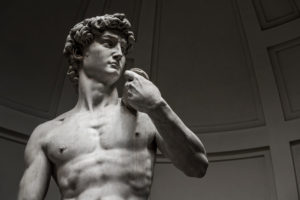Michelangelo’s David: A Humanist Symbol

The much-touted show, “Michelangelo: Divine Draftsman and Designer,” opens today at the Metropolitan Museum of Art. Comprised of 133 drawings by the Renaissance master, the exhibit will run for three months and promises quite an experience for those fortunate enough to see it.
The very first historic symbol of humanism, the sculpture David, was created by Michelangelo di Lodovico Buonarroti Simoni between 1501 and 1504. Arguably Michelangelo’s most iconic work, it was commissioned by Lorenzo de’ Medici, the ruler of the Florentine Republic.
The philosophy of humanism was first made public by Epicurus, who lived in Greece from 341 BC until 270 BC. His ideas were immortalized in the didactic philosophical poem De rerum natura (“On the Nature of Things”) by Roman philosopher Titus Lucretius Carus. The poem lay dormant in the Vatican archives until it was discovered by a member of the Medici family who served as secretary to the pope and translated the poem from Greek into Latin. Lorenzo de’ Medici read and adopted Epicureanism as the philosophical approach to life for those living in his domain. It is this view of life that initiated the Renaissance period that brought our Western civilization out of the Dark Ages and away from the dominating control of the Roman Catholic Church that had prevailed for more than one thousand years.
Michelangelo lived in Florence, and the Medicis were his patrons. He was also greatly influenced by their philosophy of life. When asked to create a sculpture that would be a symbol of man for Florence, to be displayed on the piazza beside the seat of government of the Medici, Michelangelo selected David, a symbol of a small man conquering a giant that all the people would recognize. The twenty-six-year-old Michelangelo chose a discarded piece of white marble a little over seventeen feet long and about five feet square that was quarried nearby. It was sold at a discount because it had been damaged. Since it had a corner broken off, he carved the David diagonally through the block of marble.
With Epicurean philosophy, humankind was first recognized as the center of “the nature of things.” For Michelangelo, David was the first representation of a man conquering life instead of the gods. Those who adopted the Epicurean philosophy were able to live by it for about a century before the church took over again. The humanist philosophy of life did not have enough momentum to overcome the publicly accepted meme of divinity, and it was again subverted for close to five hundred years.
Our philosophy surfaced formally again in the early 1900s, initially among Unitarian ministers living west of the Mississippi. John Dietrich was the minister of the Unitarian Church in Spokane, Washington, who reintroduced the concept that human beings are the center of human life, not God. He discussed his thinking with other Unitarian ministers and helped Rev. Curtis Reese cap his sermon on this concept—delivered in the Des Moines Unitarian Church one hundred years ago— by suggesting he call this philosophical thinking “humanism.”
Today, there are humanists around the world. There are at least twenty-million Americans who would recognize that they are humanists if they only knew that our philosophy of life exists, and that it is alright for each of us to be responsible for ourselves—that we do not have to accept a cultural meme of God that has little root in reality. Five hundred thousand Americans are connected to the American Humanist Association daily through social media. Hopefully, this third evolution of our philosophy will generate enough momentum to become the acceptable form of life for human beings and not merely tolerated by our current society.
Today, the humanist symbol is the “Happy Human,” however Michelangelo’s David was the first symbol of humanism for a society living in the Dark Ages. May it be recognized as a symbol of humanity overcoming external control, uninhibited by blind faith and a reminder that we humans control our own lives rather than our life being controlled by gods who are identified solely by others claiming authority over us. May David be our symbol for the next millennium.
